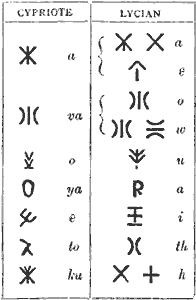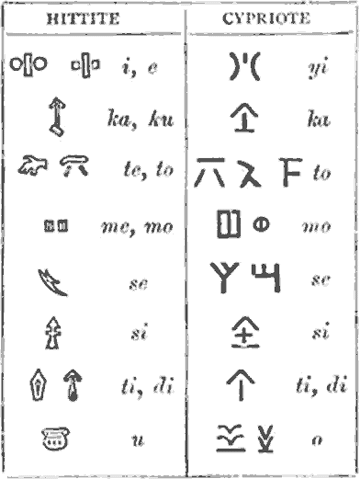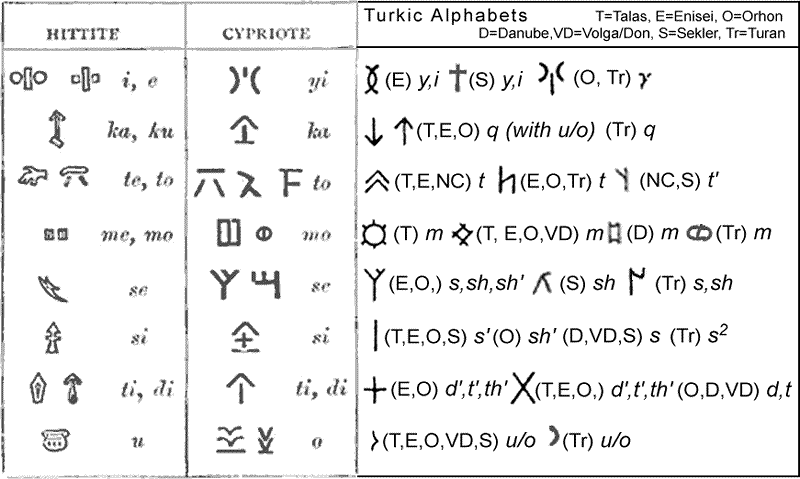|
Home Back In Russian Contents Türkic languages Codex of Inscriptions - Index |
Sources Roots Alphabet Writing Language Religion |
Genetics Geography Archeology Coins Wikipedia |
A.Toth Agglutinative languages Hunnic Writing Turanian Writing Paleography of 8 Türkic Alphabets |
Ogur and Oguz |
Alan Dateline Avar Dateline Besenyo Dateline Bulgar Dateline Huns Dateline Karluk Dateline |
Khazar Dateline Kimak Dateline Kipchak Dateline Kyrgyz Dateline Sabir Dateline Seyanto Dateline |
|||||||||||||||||||||||
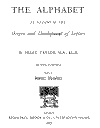 |
Isaac Taylor, M.A., LL.D. THE ALPHABET AN ACCOUNT OF THE Origin and Development of Letters London, Kegan Paul, Trench, & Co., 1883 VOL. 2, 1899
|
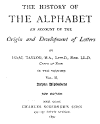 |
|||||||||||||||||||||||||||
| Vol. 1 Chapter 1. The Inventors of Writing · Vol. 1 Chapter 3. The Primitive Letters · Vol. 1 Chapter 5. The Aramean Alphabets · Vol. 2 Chapter 7 § 9 The Asianic Scripts | |||||||||||||||||||||||||||||
|
Links |
|||||||||||||||||||||||||||||
|
Introduction | |||||||||||||||||||||||||||||
|
In the section misleadingly tacked into Chapter 7 "The Greek Alphabet", Isaac Taylor, in his founding monograph, traced the provenance of a group of symbols that fall outside of the Egypto-Semitic-Greeco-Roman evolution line. These characters, that showed up in a number of Anatolian alphabets, Isaac Taylor classed as "Asianic" scripts, and traced them to an independent line of development that occupied Asia Minor in the 2nd millennia BC. Isaac Taylor traced the vestiges of that stand-alone writing script back to the Hatti-Hittite states, known at his time as a Hittite state. In the conclusion of the Asianic section I.Taylor presents a table showing examples of a genetic connection of the "Hittite" syllables with the later syllables of the Cypriote Syllabic script. That table is remarkable not only in illustration of derivation of the Cypriote Syllabic script elements from the Hatti-Hittite script, but also by allowing juxtaposition that demonstrates a remarkable resemblance of the Cypriote Syllabic elements with the letters of various Türkic scripts. S.Amanjolov initially demonstrated the probable derivation of the Eastern Asian Türkic scripts from the Phoenician in the 1971, and further substantiated that thesis in his 2003 monograph, but he stopped short of following the evolution of the Türkic scripts to the levels older than the 12th c. BC Phoenician script, and did not examined the Hatti-Hittite independent Asianic branch. Amazingly, the Türkic- Cypriotic connection was recorded among the Türkic genesis legends, see Djagfar Tarihi. From the indications that accumulated by now, we can deduce that the art of writing was transmitted, possibly by "Ki-en-gi"-Kangars-Shumers, or by a related tribe back to the Uzboi-Horesm area, since we know that Mesopotamia-Hyrcania (Tr. Yirk="nomad")-Aral belt was a range of the nomadic pastoralists, who served as a conveyor belt for the delivery of Mesopotamian culture and products to N.Caspian, N.Pontic, and Central Asian steppe people. From there it could spread to the east along with permeation of the Afanasiev Kurgan Culture, until it reached the fringes of the Chinese tribes. At that point the trail becomes visible again, in time, space, and in the development level, since the expansion of the Afanasiev Kurganians is credited with passing a number of innovations from the steppe to the eastern tribes starting ca 1700 BC. One of these innovations could be related to writing. It appears that vestiges of this process are observable in the graphics of the various Türkic scripts. The 2-volume monograph by I.Taylor, after initial interest and repeated publications, went into a 100-year hibernation period. Recently re-ignited a renewed interest, and the monograph was re-published in 2003 and 2006. The newly published editions carry ISBN numbers for Part 1 ISBN: 0766158462 ISBN-13: 9780766158467 2003 edition and ISBN 10: 1428636781 / 1-4286-3678-1 ISBN 13: 9781428636781 2006 edition, and for Part 2 0766158470 ISBN-13: 9780766158474 2003 edition and ISBN: 0548126860 ISBN: 142863679X ISBN: 0548126860 2006 edition. The graphical depictions in the text are dropped in this posting, unless they are illuminative for Türkic history. The graphics can be viewed at the above http://books.google.com link. For S.Amanjolov work about history of the Türkic alphabets, see "Genesis of Türkic Runic Alphabet". For a review of the differences between IE flexive and Turanian agglutinative languages see A.Toth "Agglutinative languages". The developments that occurred in the intervening 100 years are noted in the body of the posting, these developments do not impact or diminish Isaac Taylor's scientific contribution. Posting notes are highlighted in blue. Page numbers are shown in the beginning of the page. The author's lines that carry the main theme are highlighted, detours are shown in smaller font, and typing of some apropos notes have not been corrected. |
|||||||||||||||||||||||||||||
| § 9, THE ASIANIC SCRIPTS Vol. 2, p 108-123 | |||||||||||||||||||||||||||||
|
108 While the classical Greek alphabet was being evolved in the Ionian cities of the Asiatic coast, numerous scripts, more or less closely related to the Greek, prevailed among the non-Hellenic races. Setting aside the Aramean of the Satrapies, which has been already discussed,1 it is possible to recognize five distinct alphabets - the Lycian, the Carian, the Cappadocian, the Phrygian, and the Pamphylian; to which the Lydian, 2 the Mysian, and the Cilician may probably be added.
109 Some of these alphabets are simply archaic Greek; others appear to be unrelated either to the Greek or to the Phoenician, while the remainder contain both Hellenic and non-Hellenic elements.The Phrygian alphabet was determined by Lassen1 from the inscriptions on seven rock-cut tombs at Prymnessus, one of which was the
sepulcher of a king who bore the name of Midas. It seems to be
only an archaic type of the Greek alphabet. Thus for u, p, and g, we have the Thera forms
The scanty remains of the Mysian and Cilician scripts 2 are of a wholly different order, the characters having no recognizable relations to either the Greek or the Phoenician letters. The other alphabets of Asia Minor present a curious problem, some characters being plainly of Greek origin, and others of an unknown and mysterious type. These mixed alphabets are the Carian, the Cappadocian, the Pamphylian, and the Lycian.
110 On the knees of the colossus at Abu Simbel in Nubia, on which the Ionian mercenaries of Psammetichus engraved the cardinal monument of the early Ionian alphabet, are four records in an unknown script. It has been supposed to be Carian, since we learn from Herodotus that Carians as well as Ionians took service with Psammetichus.1 Four similar inscriptions have been found at Abydos, and others on the sites of Memphis and Bubastis (Zagazig). From Caria itself we have a single short inscription discovered by Forbes on a tomb at Krya on the Gulf of Scopea. The nature of the Carian language being unknown, these records have hitherto defied the efforts of decipherers. Apparently between thirty and forty distinct characters are employed, about half of which seem to be of the Greek type.2
The alphabet of Cappadocia is probably represented by two short inscriptions discovered at Eyuk on
the Halys, which have only been conjecturally deciphered. There are Greek letters of the Phrygian
type, such as Γ (p) and
The alphabet of the later Pamphylian inscriptions and coins is Greek of the western type, and is doubtless to be referred to Peloponnesian colonists. In the earlier records non-Hellenic characters are found.
111 These alphabets are as yet very imperfectly known, the inscriptions being few, brief, and practically undecipherable. The case is different with the Lycian. Though the language is plainly non-Aryan, it has been possible to determine with certainty the values n! all the characters except two. This result is due to the fact that among the numerous inscriptions discovered in Lycia by Sir Charles Fellowes, there are three bilinguals in Greek and Lycian, together with a long record containing 250 lines, engraved on the obelisk from Xanthus, now in the British Museum. From a Greek inscription it appears to have been erected by a Lycian satrap during the reign of Artaxerxes Longimanus (465-425 B.C.). Taking this record as an epigraphic standard, the oldest of the Lycian inscriptions have been assigned to the 6th century B.C., and the latest to the 4th when, owing to the conquests of Alexander, the Lycian alphabet was finally replaced by the Greek. The Lycian characters were mostly deciphered by Sharpe, whose
labors were completed by Schmidt.
There are twenty-eight letters» about half of which are Greek, the rest being curious and
complicated forms found in no Greek alphabet. The fourteen consonants, with two exceptions,
+ h and
)( th, are archaic Greek of the Phrygian type. Of the fourteen vowels, four,
Α Ε Ι Ο, are also
Greek, the others, which constitute an elaborate and delicate system of vocalic notation, being
non-Hellenic. The Greek letters do not appear to have been obtained, as might have been expected,
from the contiguous alphabet of Ionia, but, as is shown
by the forms 112 For nearly forty years after the recovery of the Lycian alphabet the nondescript characters,
amounting to about half of the whole number, were supposed 1 to be merely fantastic and arbitrary
inventions, based possibly on Greek forms. It is only within the last two or three years that the
origin and true nature of these signs has been made clear. The explanation, now that it has been
found, illustrates strikingly the axiom that abnormal forms are of supreme epigraphic significance,
constantly affording the clue to great discoveries. The light came at last from an
unexpected source. In 1852 the due de Luynes 2 published
certain coins and inscriptions from Cyprus in an unknown character, to which the name of Cypriote
was given. In 1868 de Vogue added others, among which was a short bilingual in Greek and Cypriote.3
This might easily have led to the decipherment of the character, but no results were obtained,
owing, as it now appears, to the incorrectness of the transcription.
1 See Kirchhoff, Studien, p. 47 (1877). Lenormant, Alphabetum,
p. 209, (1873), pronounces them to be 'combinaisons purement artificiellcs.' 113 In the next year, however, Mr. Hamilton Lang discovered at Dali,
on the site of the ancient Idalion, a longer bilingual, containing no less than one hundred Cypriote
characters, with a Phoenician translation dated in the 4th year of Melekiathon, about 375 B.C.1 The tablerhaving been deposited in the British Museum, was submitted to the examination of the late
George Smith. By means of the Phoenician version, and skilfully availing himself of the aid of
Cypriote coins, he succeeded in identifying the proper names in the two records, and in determining
the phonetic values of several of the mysterious characters which had for nearly twenty years defied
the efforts of decipherers. The title of the Cypriote monarch, corresponding to the word Melek in
the Phoenician version, proved to be Ba-si-le-u-se, whence it followed that the unknown Cypriote
language, which had excited so much curiosity, was neither more nor less than Greek! The clue thus
happily discovered was at once followed up by an eager band of scholars, chief among whom the names
of Birch, Brandis, Schmidt, Ahrens, Deecke, and Siegismund deserve honourable mention, who soon
placed on a firm foundation the interpretation of the
Cypriote texts, now amounting to a considerable number. The numerous variant forms were reduced to
between fifty and sixty types, which were shown to constitute not an alphabet, but a syllabary.
114 .As an example of the Cypriote script, we may take the inscription of ownership on some gold armlets from Kurion, which must have belonged to Ithyandros, the king of Paphos who rendered homage to Assurbanipal when that monarch marched on Egypt, B.C. 620. 1
There could be little doubt that the Cypriote
syllabary, thus curiously recovered, was no arbitrary
invention, but the survival of an extremely ancient
script, which must have prevailed in Cyprus prior to
115 .This explanation was received with hesitating, but general acquiescence, till the publication of Schliemann's Ilios in 1880. In an Appendix to this work Professor Sayce discussed the characters inscribed on the Trojan whorls found in the lower stratum at Hissarlik, some of them at a depth of more than thirty feet, below the surface, and succeeded in showing that they must be regarded as archaic form of Cypriote characters.1 The chronological and geographical inferences drawn from this startling discovery were not only fatal to Dr. Deecke's proposed derivation of the Cypriote from the Cuneiform in the 8th century BC, but suggested the true solution of thiss and other problems not less perplexing.It was manifest not only that, writing was practiced in the Troad before the introduction of either the Phoenician or the Greek alphabet, but that the non-Hellenic characters in the Lycian, Carian, and Cappadocian alphabets, as well as the Cypriote syllables, were all derived from a common sorce 3, a syllabic writing, evidently of immense antiquity, which prevailed throughout the whole of Asia Minor, and which has been designated by Professor Sayce as the Asianic syllabary.
116 It must have been owing to the insulation of Cyprus that this primitive script lingered there down to historic times, elsewhere giving place to the Greek alphabet, which, however, incorporated certain signs from the older script.The mysterious characters in the alphabets of Asia Minor now receive a very easy explanation. We have for example:
117 The Cypriote signs also explain many of the unknown characters in other Asianic alphabets. Thus
the Cypriote To the student of Alphabets the Cypriote syllabary is of great interest as an example of an independent graphic system, unrelated to the Semitic alphabet, which was rapidly advancing on the path of alphabetic evolution at the time when it became extinct. Its further development was arrested by the competition of an alphabet which having already reached a more advanced stage, proved successful m the struggle for existence. If it had not been thus superseded, it would doubtless have gradually lost its syllabic character, and have become the definitive alphabet of Greece, and therefore of civilized Europe and of the western world. 2
118 The Lycian alphabet claims attention chiefly as an abortive attempt to solve the problem of vocalic notation. This was effected by the Greeks by the process of internal evolution, symbols for the vowels being developed out of the Semitic breaths and semi-consonants, while the Lycians attained the same end by the incorporation of characters derived from another graphic system.1Certain chronological inferences are suggested by the fact that while the consonants of the Lycian alphabet are, as a rule, of Greek origin, the non-Hellenic characters represent vowels. It would seem that in Lycia the Greek alphabet came into competition with the Asianic syllabary before the Cypriote syllables had become consonants, and before the Greek vowels had been fully developed. The best elements of each system were taken. Greek letters representing pure consonants replaced the clumsier syllables, and were combined with the elaborate and delicate notation for the vowels which was possessed by the rival script. It is especially worthy of note» as an indication of date, that npsilon, which already appears in the earliest of the Thera records, is not found in the Lycian alphabet, which only possesses the four oldest of the Greek vowels, Α Ε Ι Ο. Hence it may be concluded that the formation of the Lycian alphabet belongs to a period more remote than any of which we possess direct epigraphic knowledge.
119 This conclusion agrees with all the other available evidence. Dr. Schliemann's whorls from Hissarlik tend to prove that at the time of the destruction of Troy the only graphic signs used in Mysia were the Asianic syllables, which may probably be identified with the σήματα λυγρά (semata ligura, "Semitic letters" - Translator's Note) of Homer (Il. vi. 168). As we shall presently see, the Asianic syllabary must have been employed throughout Asia Minor long before the arrival of the Phoenician colonists in the Aegean in the 12th century B.C. In the 7th century the Cypriote writing was already obolescent (i.e. becoming a dying whorl [adj.] - Translator's Note) in Cyprus, and yet the Cypriote syllabary was plainly only a late survival of the more comprehensive 1 and more archaic syllabary of Asia Minor.
To complete the solution of the problem offered by the Asianic alphabets one step only was required. namely, the discovery of the source from which the Cypriote syllabary was itself obtained. It had no recognizable affinities with the graphic systems of the Greeks, the Phoenicians, the Egyptians, or the Assyrians, but the analogy of other scripts made it probable that it was the ultimate survival of some extremely ancient mode of picture-writing.
120 The recent discovery of the so-called "Hittite" hieroglyphs has cast a flood of fresh light upon the question. In 1871, Mr. Tyrwhitt Drake obtained copies of five inscriptions in an unknown hieroglyphic character from Hamath on the Orontes, and others of a similar nature have recently been excavated from a mound (kurgan) at Jerabis, on the upper Euphrates, which has been identified with the site of Carchemish, the northern capital of the Hittites. That their empire extended as far as the Euxine and the Aegean is shown by hieroglyphs and sculptures in the unmistakable style of Hittite art, which are scattered over Asia Minor, more especially in Lydia, Lycaonia, Cappadocia, and Cilicia. 1 These monuments are those of a people who have been identified with the Hittites (Khittim) of the Old Testament, the Kheta of the Egyptian monuments, the Khattai of the Assyrian records, and the Κητειοι of Homer (Od. xi. 521). They were one of the most powerful peoples of the primeval world, their empire extending from the frontier of Egypt to the shores of the Aegean, and, like the Babylonians and the Egyptians, they possessed a culture, an art, and a script peculiar to themselves, and plainly of indigenous origin.
121 Scholars are only just beginning to realize the vast extent of the dominion of the Hittites, and their important place in primitive history. Till the rise of Assyria they were the most powerful nation in North Western Asia; after that event they held the balance of power between Egypt and Assyria. Dr. Schiemann's discoveries at Troy and the Hittite monuments scattered over Asia Minor, as far west as the neighborhood of Smyrna, prove the extent oft their empire to the west, 1 while to the south, at a time prior to the Exodus of the Hebrews, their dominion extended as far as Hebron, and, if Mariette is right in his belief that one of the Hyksos dynasties was Hittite, they must have established their rule over Egypt itself. In the 17th century Thethmes III., the greatest of Egyptian conquerors, claims to have exacted tribute from the Kheta as well as ftrom Nineveh and Babilon. In the 14th century they contended against Egypt on equal terms. The most important event in the reign of Rameses II., sculptured on a host ofi temples and celebrated in the epic poem of Pentaour, is his campaign against the Kheta, terminated by the indicisive battle of Kadesh, resulting in a treaty in which both parties pledged themselves not. to invade the dominions of the other.
122 In the 12th century, when the Phoenicians advanced to the Aegean, the Hittite power had begun to decline, and by the time of Solomon their empire was broken up into separate kingdoms by internal divisions, and weakened by the encroachments of neighboring Semitic nations, and was finally brought to an end in 717 B.C. by the capture of Carchemish by the Assyrians under Sargon. Their speech was clearly neither Aryan nor Semitic, and seems to have belonged to the great Alarodian family which was spoken in Cilicia, Cappadocia, Lycaonia, and Armenia, and whose nearest living representative is believed to be the language of the modern Georgians.
This powerful Hittite empire, stretching from the Euphrates to the Aegean, from Syria to the Euxine, attained its greatest extension between the 17th and 14th centuries, long before these regions were affected by either Phoenician or Assyrian influences. It is now admitted that the primitive art, the mythology, and the metrical standards of Asia Minor were to a great extent obtained from the Hittites, and the independent system of picture-writing which they possessed offers an obvious source from which the Asianic syllabary might have been obtained. That this was actually the case there is every reason to believe. Professor Sayce has succeeded in assigning phonetic values to several of the Hittite hieroglyphics; and these, with hardly an exception, explain the origin of homophonic characters in the Asianic and Cypriote scripts. Some of these identifications are set forth in the following Table. In the present state of Hittite decipherment they can only claim to be provisional, but they may perhaps suffice to show that the true origin of the Cypriote syllabary has at last been discovered.
123
|
|||||||||||||||||||||||||||||
|
Fast Forward |
|||||||||||||||||||||||||||||
|
In their 1979 publication,
I.M.Dunaevskaya and I.M.Diakonov stipulate that Hattian (proto-Hittite) language morphologically and
lexically is connected with the Adyg language group, less so woth the Kartwellian language group,
and has no connections with the Nakh language group, which I.M.Diakonov linked with the Hurrian and
Urartu languages.
I.M.Dunaevskaya, I.M.Diakonov ...Hattian language, displaying presumable (morphological) elements similar with Abhazo-Adyg and, maybe, with Kartwelian languages, does not display common features with Northern-Eastern-Caucasian languages (euphemism for Nakh language group) (in contrast with Hurrian and Urartian). ...To establish possible relationship between the Hattian and Abhazo-Adyg languages also were considered the following (lexical) facts: a) The Hattian character of the onomastics of the Kask, or Kashk tribe, which in the 2nd millennium BC occupied the north-eastern Asia Minor (area of Pontus abutting in the east to Colchis - G.G.Giorgadze); b) The similarity of ethnonyms Kas/shk- and Abeshla- (one of the tribes in the same area) with ancient Georgian (Kartwelian) Kashag, Old Rus Kosog "Circassian", "Adyg", and with Greek Apsilai, Lat. Absilae, ancient Georgian Ap'sil-eti - the name of a tribe (in Georgia - province) in the area of r. Kodori (Lat. Absilis) in Abkhazia (G.A.Melikishvili). Alsocompare the self-name of Abhaziand - a-ap'sh-wa (-wa - pl.). |
|||||||||||||||||||||||||||||
|
| |||||||||||||||||||||||||||||
